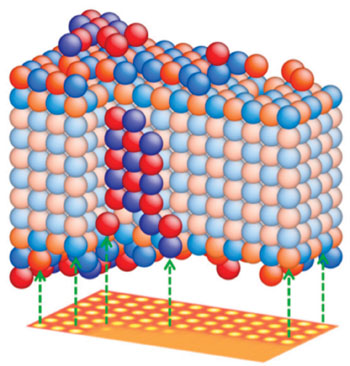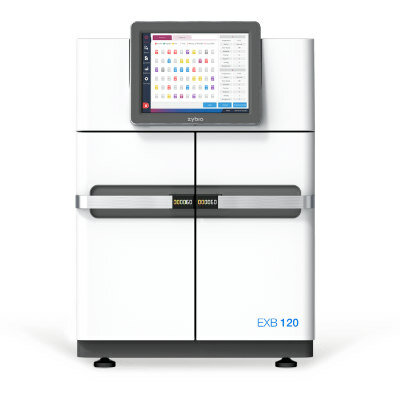Electron Microscopy Advance Rebuilds Third Dimension from Just One Image
By LabMedica International staff writers
Posted on 01 Oct 2014
Scientists have developed a new nanotechnology strategy with which crystal structures can be reconstructed with atomic precision in all three dimensions (3D).Posted on 01 Oct 2014
Researchers have used an image from an ultrahigh resolution electron microscope. The process is also especially suitable for the spatial mapping of radiation-sensitive samples, which would be quickly destroyed by the high energy measurement beam. The results were published on September 21, 2014, in the scientific journal Nature Materials.

Image: From the electron microscope image of nanocrystals—here, a magnesium oxide nanocrystal— below, the three-dimensional structure is reconstructed with atomic precision using a new method developed by researchers from Jülich and Xi’an. The red spheres represent magnesium, the blue, oxygen (Photo courtesy of Forschungszentrum Jülich).
A key feature of nanoparticles is that they differ from other types of substances in that their surface determines their physical and technical properties to a much larger degree. The effectiveness of catalysts, for instance, depends mostly on the shape of the materials used and their surface texture. For this reason, physicists and material scientists are interested in being able to determine the structure of nanomaterials from all angles and through several layers, right down to the last atom.
Until now, it was necessary to perform a whole series of tests from different angles to achieve this. However, scientists from the Forschungszentrum Jülich (Jülich Research Center; Jülich, Germany), the Jülich’s Ernst Ruska-Center for Microscopy and Spectroscopy with Electrons (ER-C), and Xi'an Jiaotong University (Xi'an, Shaanxi, China) have now succeeded for the first time in calculating the spatial arrangement of the atoms from just one image from an electron microscope.
Their approach offers many benefits: radiation-sensitive samples can also be examined, which would otherwise be rapidly damaged by the microscope’s high-energy electron beam. The comparatively short data acquisition time involved could even make it possible in the future to see the transient intermediate steps of chemical reactions. Furthermore, it enables a “gentle” measurement procedure to take place, to detect not only heavy but also light chemical elements, such as oxygen, which have a vital function in many technologically important materials.
“Acquiring three-dimensional information from a single two-dimensional image seems impossible at first glance. Nevertheless, it is in fact possible: we don’t obtain a simple two-dimensional projection of the three-dimensional sample as the experiment follows quantum mechanical principles instead,” explained Prof. Chunlin Jia, a researcher from the Jülich Peter Grünberg Institute, in microstructure research (PGI-5), the ER-C and at Jiaotong University. “On its way through the crystal lattice, the electron wave of the microscope acts as a highly sensitive atom detector and is influenced by each individual atom. The key point is that it does actually make a difference whether the wave front encounters an atom at the beginning or at the end of its pathway through the crystal.”
For the new 3D measuring process, a thin crystalline sample, in this instance, magnesium oxide, is positioned in the microscope so that the atoms at the intersections of the crystal lattice lie precisely on top of one another, forming columns along the observation axes. These atom columns are later only visible as bright spots on the microscopic image. A special imaging mode is used to improve the signal-to-noise ratio. In this way, subtle variations are visible, which show the researchers the location of individual atoms in the columns along the beam direction.
To reconstruct the spatial structure, the scientists compared the image with calculations constructed on a computer. The computer simulations provide an idea of how a microscopic image of a completely flat magnesium oxide crystal would look. After this, they matched up the model crystal step by step until the reconstructed figure corresponds optimally with the image from the electron microscope.
To validate the findings, the scientists performed comprehensive statistical tests. These revealed that the strategy is not only sensitive enough to identify each individual atom, but also to distinguish between the magnesium and oxygen elements of the crystal.
Related Links:
Forschungszentrum Jülich
Ernst Ruska-Centre for Microscopy and Spectroscopy with Electrons
Xi'an Jiaotong University













